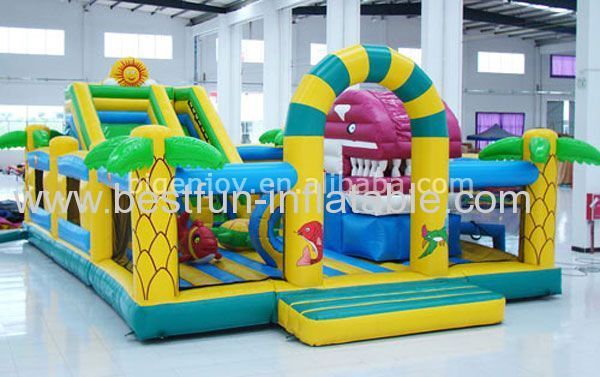
1. Safety: The primary consideration in the design of children's amusement parks is to ensure the safety of children. All amusement facilities must comply with relevant safety standards, materials and structures should be stable and reliable, and sharp and dangerous components should be avoided as much as possible. When designing, it is necessary to consider the age characteristics and ability level of children, and set appropriate heights, slopes, and safety measures, such as safety nets, guardrails, anti slip floors, etc., to prevent accidents from occurring.
2. Diversity and interactivity: Outdoor children's amusement parks should provide diverse and interactive amusement facilities, encouraging children to participate in various activities and games. Various climbing facilities, slides, swings, turntables, etc. can be designed to meet the needs of children of different age groups. At the same time, some group games and team activities can be set up to promote social and cooperative activities among children.

3. Comfort and convenience: The design of children's amusement parks should focus on comfort and convenience. Provide sufficient rest areas, green spaces, and shading facilities for children and parents to rest and observe. Reasonably plan channels, seats, sanitary facilities, etc. to facilitate the use of children and parents. At the same time, considering the special needs of children, such as setting lower faucets, smaller tables and chairs, to provide them with a better user experience.
4. Environmental integration and theme design: The design of outdoor children's amusement parks should consider environmental integration and theme design, creating interesting and attractive scenes. We can utilize natural landscapes and vegetation to create an amusement park that is harmonious and unified with the surrounding environment. In addition, you can also choose some interesting themes, such as animals, fairy tales, oceans, etc., and increase children's interest and participation through the decoration of theme elements and the design of amusement facilities.
5. Educational and Cultural: The design of children's amusement parks can incorporate educational and cultural elements, adding educational and cultural content. Design activities and facilities that are beneficial for children's learning and development, such as scientific experimental areas, artistic creation areas, etc. At the same time, it can showcase local culture, customs, and traditions, allowing children to come into contact and understand them in games

In summary, the design of outdoor children's amusement parks needs to consider factors such as safety, diversity, interactivity, comfort, convenience, environmental integration, theme design, education, and culture, in order to provide children with a safe, interesting, and rich outdoor play space.
2. Diversity and interactivity: Outdoor children's amusement parks should provide diverse and interactive amusement facilities, encouraging children to participate in various activities and games. Various climbing facilities, slides, swings, turntables, etc. can be designed to meet the needs of children of different age groups. At the same time, some group games and team activities can be set up to promote social and cooperative activities among children.

3. Comfort and convenience: The design of children's amusement parks should focus on comfort and convenience. Provide sufficient rest areas, green spaces, and shading facilities for children and parents to rest and observe. Reasonably plan channels, seats, sanitary facilities, etc. to facilitate the use of children and parents. At the same time, considering the special needs of children, such as setting lower faucets, smaller tables and chairs, to provide them with a better user experience.
4. Environmental integration and theme design: The design of outdoor children's amusement parks should consider environmental integration and theme design, creating interesting and attractive scenes. We can utilize natural landscapes and vegetation to create an amusement park that is harmonious and unified with the surrounding environment. In addition, you can also choose some interesting themes, such as animals, fairy tales, oceans, etc., and increase children's interest and participation through the decoration of theme elements and the design of amusement facilities.
5. Educational and Cultural: The design of children's amusement parks can incorporate educational and cultural elements, adding educational and cultural content. Design activities and facilities that are beneficial for children's learning and development, such as scientific experimental areas, artistic creation areas, etc. At the same time, it can showcase local culture, customs, and traditions, allowing children to come into contact and understand them in games

In summary, the design of outdoor children's amusement parks needs to consider factors such as safety, diversity, interactivity, comfort, convenience, environmental integration, theme design, education, and culture, in order to provide children with a safe, interesting, and rich outdoor play space.
